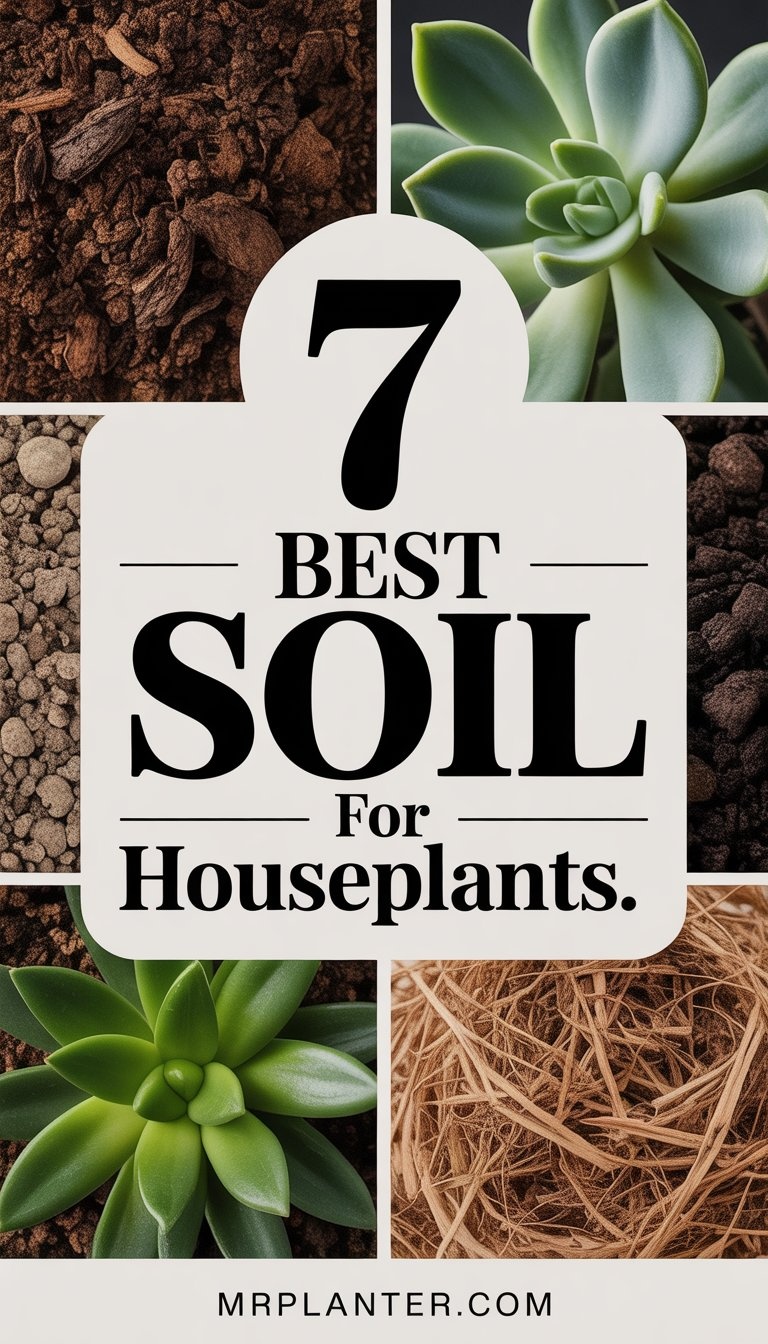Ever brought home a new plant, watched it droop, and wondered what you did wrong?
Honestly, sometimes it’s just the soil. Houseplants want more than plain old dirt—they need a good mix that lets their roots breathe, drains well, and holds on to just enough moisture.
The right soil can be the difference between a plant that goes wild with growth and one that just sits there looking sad.
Different plants? Oh, they’re picky. Cactus? Loves a quick-draining blend. Fern? Wants to stay a bit damp. When you pick soil for your houseplants, matching the mix to your plant’s style is the real secret.
Always peek at the ingredients, feel the texture, and make sure there’s no sign of pests or mold in the bag.

Once you know what to look for, choosing soil doesn’t feel like a guessing game. I’ve tested and compared a bunch of popular options to see which ones actually help your plants grow big and happy.
Best Soil for Houseplants
We all want our plants to look amazing, right? The right soil really does most of the heavy lifting. My picks below give you mixes that drain well, keep the roots comfy, and serve up the nutrients your green babies crave.
You’ll find something here that fits both your plant’s needs and your own “how often do I water?” routine.
Miracle-Gro Houseplant Potting Mix

Want healthy, chill houseplants without a gnat invasion? This mix has your back.
Pros
- Feeds plants for months—no extra work needed
- Drains well, keeps roots from drowning
- Gnats don’t seem to like it (thank goodness)
Cons
- Bag runs small if you’ve got a plant jungle
- Texture might feel too fine for some chunky-rooted plants
- Costs a bit more than your basic stuff
I tried this on my pothos, and wow, it looked happier in days. The leaves perked up, and I didn’t have to mess with extra fertilizer. It’s nice when something actually works without drama.
You’ll notice right away—it’s airy but not dry. My monstera’s roots spread out with no trouble, and watering didn’t turn into a swampy disaster. No root rot nightmares here. That’s a win.
And the gnats? Gone. If you’ve ever battled those little guys, you know what a relief that is. Just a heads up, though—the bag empties fast, so grab two if you’ve got a mini forest indoors.
Back to the Roots Indoor Potting Mix

Looking for an organic soil that keeps plants happy and pests away? This mix is a good bet.
Pros
- Holds moisture—no crispy, thirsty plants
- Light and crumbly, so potting isn’t a pain
- Pet-safe and gnat-resistant (no compost to attract bugs)
Cons
- Might stay damp longer than some plants like
- Sometimes needs extra perlite for drainage
- A few folks spotted mold if they overwatered
This one’s soft and crumbly right from the bag. No fighting with clumps or bark chunks. The yucca extract actually helps keep the soil from drying out too quickly, which is perfect if you forget a watering now and then. I found it super handy for small pots that usually dry out in a blink.
It smells earthy and clean—no weird bark or compost. My peace lily perked up after I switched, and the leaves got greener. Plus, it’s peat-free, so you’re making a greener choice.
Just keep an eye on how wet it gets. If your plant likes things on the drier side, mix in some perlite or orchid bark. As long as you don’t go wild with the watering, it’s a solid, easy option for most houseplants.
Miracle-Gro Indoor Potting Mix

Need a no-fuss, low-mess soil that keeps your plants happy? This one’s a strong pick.
Pros
- Feeds plants for months—set it and forget it
- Stays light and fluffy, so roots don’t suffocate
- Gnats stay away (hallelujah)
Cons
- Dries out faster than some heavier mixes
- Not great for plants that like dense soil
- Bags are on the small side for big jobs
Open the bag and you’ll feel how light and fluffy it is. You can scoop it up with your hands—no muddy mess, no clumps. Pouring it into pots is easy, and it doesn’t spill everywhere.
I tried it on pothos and peace lily, and both settled in fast. Roots spread out with no stubborn hard spots. Water drains through, so you avoid soggy bottom syndrome.
Heads up: it dries out a bit quicker than heavy blends. If you’re the type who overwaters, this is perfect. If your plant likes to stay damp, check it more often. For most houseplants, though, it’s a simple, reliable choice that makes repotting way less of a chore.
FoxFarm Ocean Forest Potting Soil

Need a grab-and-go soil that keeps your houseplants thriving? This one works great.
Pros
- Holds moisture without drowning roots
- Light, fluffy texture—no mess, no stress
- Loaded with natural nutrients from earth and sea
Cons
- More expensive than the basic stuff
- Bag is big and a bit heavy
- Might be too rich for very delicate seedlings
First thing I noticed? How fluffy this soil feels. You can dig your hands in—no clumps, no hard bits. It’s easy to use, especially indoors.
It balances moisture nicely. My plants stayed hydrated longer, but roots never sat in muck. That sandy loam and peat moss combo really works. If you forget to water sometimes (hey, it happens), this soil forgives you.
It’s packed with nutrients right out of the bag. I skipped fertilizer for weeks, and my plants still put out new leaves. For baby seedlings, maybe use something gentler, but for most houseplants, this is a winner.
If you want a bag that’s ready to roll the second it arrives, FoxFarm Ocean Forest makes planting almost too easy. Just be ready to flex when you carry it inside.
Miracle-Gro Organic Indoor Potting Mix

Looking for a reliable, easy soil that keeps your houseplants happy? This mix is a solid pick.
Pros
- Holds moisture but never gets swampy
- Fluffy and light—planting is a breeze
- Works for seeds, herbs, and mature plants
Cons
- Has a bit of an earthy smell when you first open it
- Needs a nutrient boost after a few months
- Bags feel small if you’re repotting a bunch
When I opened this bag, the fluffy, soft texture stood out. No heavy clumps, so scooping and filling pots was easy. The coir in the mix keeps it light while still holding water.
I used it for repotting pothos and starting basil seeds. Both settled in fast, and I didn’t need to water every day. It strikes a good balance—moist but never swampy.
After a while, you might want to add some fertilizer, but for starting out or giving plants a fresh home, this soil makes things easy and low-stress. If you want drama-free soil, this one’s a good choice.
Sol Soils Chunky Houseplant Mix

Looking for soil that lets your roots breathe easy, drains like a champ, and doesn’t turn into a swamp? This mix hits all those marks.
Pros
- Holds moisture but doesn’t stay soggy
- Chunky bits keep roots happy and airy
- Made from sustainable, peat-free stuff
Cons
- Dries out fast if your air’s dry
- Costs a bit more for the amount
- If it gets bone dry, you’ll need to pre-wet it
Plant folks who’ve watched roots turn to mush (guilty) might just fall in love with this one. Those coconut husk and bark chunks keep things light, so your plants won’t drown in their own pots.
When I tried it with my Monstera, new leaves popped up in just a few weeks. The mix feels super light, drains fast, and doesn’t squish down over time.
You’ll probably water more often if your place is dry, but honestly, I’ll trade that for roots that actually want to grow.
Heads up—if you let it dry out all the way, it can be a little stubborn about soaking up water again. I found that pouring water on in layers does the trick.
It’s not the cheapest bag on the shelf, but the quality and earth-friendly vibe make it feel like money well spent.
Rosy Soil Indoor Potting Mix

Want a potting mix that’s clean, keeps your plants perky, and doesn’t invite a gnat party? This one’s a strong contender.
Pros
- Holds onto moisture without going swampy
- No peat, so you’ll see fewer gnats
- Smells fresh and looks rich right out of the bag
Cons
- Price is higher than regular potting soil
- Some folks spot mushrooms growing in their pots
- Might hold too much water for plants that like things dry
I ripped open the bag and noticed right away how light and crumbly it felt. No heavy, clumpy stuff here.
My monstera and pothos seemed to settle in quick, and I didn’t have to water as often. The biochar and pine bark mix lets roots get air and moisture at the same time.
That’s a lifesaver if you’re known to overwater. Plus, it doesn’t have that weird musty smell that some peat soils do.
Just a heads up—if your plants live in low light and you water a lot, this mix might stay damp longer than you expect. On the bright side, I haven’t seen a single gnat since switching, and that feels like a miracle for indoor plant life.
Buying Guide
When you’re shopping for houseplant soil, don’t just grab the prettiest bag on the shelf. Think about what your plants actually want.
First, check out the texture. Grab a handful if you can—does it feel light and crumbly? That’s good. If it’s heavy and clumpy, your plant roots might end up gasping for air.
Peek at the ingredients list next. If you spot peat moss or coco coir, that’s usually great for holding just the right amount of moisture. Perlite or pumice? Those help the roots breathe. Compost gives your plants a snack. Honestly, skip the mixes packed with sand unless your plant is a cactus or something desert-y.
Moisture control is a big deal. Got a plant that hates soggy roots? Pick a fast-draining mix. If you’re growing something tropical, go for soil that hangs onto water a bit longer.
Here’s a handy table to keep things straight:
| Feature | Why It Matters | What to Look For |
|---|---|---|
| Drainage | Prevents root rot | Perlite, pumice, bark |
| Moisture Retention | Keeps plants hydrated | Peat moss, coco coir |
| Nutrients | Supports healthy growth | Compost, worm castings |
| Texture | Helps roots breathe and grow | Loose, airy feel |
Match your soil to your plant. Succulents? They love gritty stuff. Ferns? They’re all about that moisture.
And honestly, don’t stress—just try a small bag if you’re not sure. Plants usually let you know if they’re happy. If you see new leaves, you’re probably doing something right. If not, well, they’ll throw a little plant tantrum and you’ll know to switch things up.

